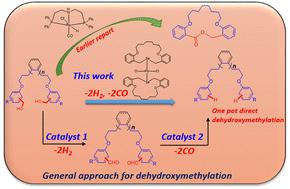当前位置:
X-MOL 学术
›
Dalton Trans.
›
论文详情
Our official English website, www.x-mol.net, welcomes your
feedback! (Note: you will need to create a separate account there.)
A palladium complex of a macrocyclic selenium ligand: catalyst for the dehydroxymethylation of dihydroxy compounds
Dalton Transactions ( IF 3.5 ) Pub Date : 2023-03-08 , DOI: 10.1039/d3dt00375b Sunil Kumar 1 , Sohan Singh 1 , Suman Mahala 1 , Prachi Janjani 2 , S Rajagopala Reddy 2 , Tanmay Rom 3 , Avijit Kumar Paul 3 , Partha Roy 2 , Hemant Joshi 1
Dalton Transactions ( IF 3.5 ) Pub Date : 2023-03-08 , DOI: 10.1039/d3dt00375b Sunil Kumar 1 , Sohan Singh 1 , Suman Mahala 1 , Prachi Janjani 2 , S Rajagopala Reddy 2 , Tanmay Rom 3 , Avijit Kumar Paul 3 , Partha Roy 2 , Hemant Joshi 1
Affiliation

|
This report describes the synthesis of a seventeen-membered macrocyclic ring containing ligand (L1) by the reaction of 1,8-bis(2-(chloromethyl)phenoxy)octane with selenium powder. The trans-palladium dichloride complex (C1) of the macrocyclic selenium ligand was synthesized from its reaction with the Pd(CH3CN)2Cl2 precursor. The formation of the ligand and complex was authenticated with the help of various analytical techniques like 1H and 13C{1H} NMR, HRMS, FTIR, UV-visible spectroscopy, and elemental analysis. The structure of the ligand and its coordination mode with the palladium precursor were authenticated with the help of single crystal X-ray diffraction. The complex possesses a distorted square planar geometry around the palladium center. The new ligand and complex are air and moisture insensitive and stable at room temperature for over three months. The variable temperature NMR data and computational studies suggest selenium inversion in the palladium complex (C1) with an inversion barrier of ∼22.6 kcal mol−1. The palladium complex C1 was used as a catalyst for the dehydroxymethylation of long alkyl chain containing dihydroxy compounds. Generally, two separate catalysts are used for dehydroxymethylation (one for the oxidation of the alcohol and the other for the decarbonylation of the aldehyde). Here a single catalyst shows the dual action of dehydroxymethylation with up to 91% yield under only 5.0 mol% catalyst loading. A broad substrate scope can be achieved with good functional group tolerance. The PPh3 and Hg poisoning tests suggest the homogeneous nature of the reaction. Interestingly, the same long alkyl chain containing dihydroxy compounds were reported to undergo macrolactonization when reacted with a ruthenium catalyst.
中文翻译:

大环硒配体的钯络合物:二羟基化合物脱羟甲基化的催化剂
本报告描述了通过 1,8-双(2-(氯甲基)苯氧基)辛烷与硒粉的反应合成含有配体 ( L1 )的十七元大环。大环硒配体的反式-二氯化钯络合物( C1 )是通过其与Pd(CH 3 CN) 2 Cl 2前体的反应合成的。借助1 H 和13 C{ 1等各种分析技术验证了配体和复合物的形成H} NMR、HRMS、FTIR、紫外-可见光谱和元素分析。借助单晶 X 射线衍射验证了配体的结构及其与钯前体的配位模式。该复合物在钯中心周围具有扭曲的方形平面几何形状。新的配体和复合物对空气和湿气不敏感,并且在室温下稳定三个月以上。变温核磁共振数据和计算研究表明钯络合物 ( C1 ) 中的硒反转具有~22.6 kcal mol -1的反转势垒。钯配合物C1用作含二羟基化合物的长烷基链脱羟甲基化的催化剂。通常,两种单独的催化剂用于脱羟甲基化(一种用于醇的氧化,另一种用于醛的脱羰基)。在这里,单一催化剂显示出脱羟甲基化的双重作用,在仅 5.0 mol% 的催化剂负载下,收率高达 91%。具有良好的官能团耐受性可以实现广泛的底物范围。PPh 3和 Hg 中毒试验表明反应的均相性质。有趣的是,据报道,含有二羟基化合物的相同长烷基链在与钌催化剂反应时会发生大环内酯化。
更新日期:2023-03-08
中文翻译:

大环硒配体的钯络合物:二羟基化合物脱羟甲基化的催化剂
本报告描述了通过 1,8-双(2-(氯甲基)苯氧基)辛烷与硒粉的反应合成含有配体 ( L1 )的十七元大环。大环硒配体的反式-二氯化钯络合物( C1 )是通过其与Pd(CH 3 CN) 2 Cl 2前体的反应合成的。借助1 H 和13 C{ 1等各种分析技术验证了配体和复合物的形成H} NMR、HRMS、FTIR、紫外-可见光谱和元素分析。借助单晶 X 射线衍射验证了配体的结构及其与钯前体的配位模式。该复合物在钯中心周围具有扭曲的方形平面几何形状。新的配体和复合物对空气和湿气不敏感,并且在室温下稳定三个月以上。变温核磁共振数据和计算研究表明钯络合物 ( C1 ) 中的硒反转具有~22.6 kcal mol -1的反转势垒。钯配合物C1用作含二羟基化合物的长烷基链脱羟甲基化的催化剂。通常,两种单独的催化剂用于脱羟甲基化(一种用于醇的氧化,另一种用于醛的脱羰基)。在这里,单一催化剂显示出脱羟甲基化的双重作用,在仅 5.0 mol% 的催化剂负载下,收率高达 91%。具有良好的官能团耐受性可以实现广泛的底物范围。PPh 3和 Hg 中毒试验表明反应的均相性质。有趣的是,据报道,含有二羟基化合物的相同长烷基链在与钌催化剂反应时会发生大环内酯化。


















































 京公网安备 11010802027423号
京公网安备 11010802027423号